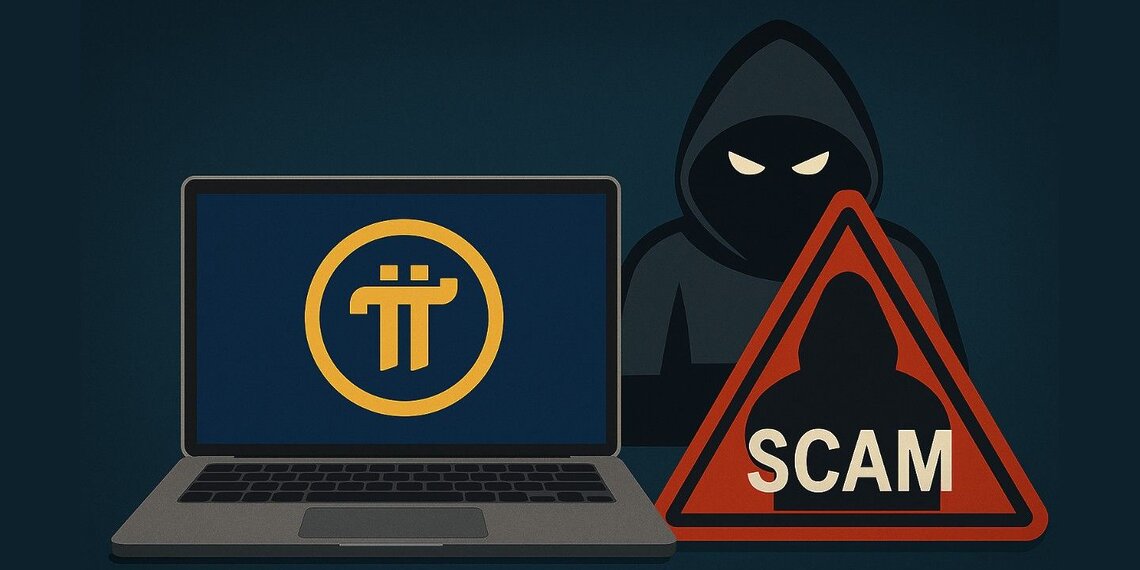Pi Network, launched in 2019, aims to democratize cryptocurrency mining via a mobile app, making it accessible to “everyday people”. Annually, June 28 marks “Pi2Day,” a key community event for feature launches and updates. This year, however, cybercriminals exploited Pi2Day with a sophisticated malicious advertising campaign on platforms like Facebook, using official branding to direct users to deceptive phishing pages and distribute harmful malware. This alarming incident highlights the critical vulnerability of Pi’s large, often novice user base to professional fraudsters.
Understanding Pi Network: The Vision and Its Evolution
Founded by Stanford graduates, Pi Network enables mobile “mining” using a lightweight consensus algorithm based on the Stellar Consensus Protocol (SCP) or Stellar Federated Byzantine Agreement (FBA). Users “mine” by daily engagement and can boost their rate by inviting others, forming “Security Circles”. The Pi cryptocurrency has a maximum supply capped at 100 billion tokens, with new issuance slated to halt once the network achieves 100 million users.
The network transitioned to an Enclosed Mainnet in December 2021, restricting external connectivity to allow for ecosystem development and Know Your Customer (KYC) verification. While an Open Network mainnet was announced for February 2025, millions reportedly remain in the Enclosed Mainnet, unable to freely trade Pi, which fuels persistent skepticism. Pi2Day events are highly anticipated for significant updates, such as “.pi” domains or potential AI integration. However, these expectations have sometimes led to disappointment, contributing to price volatility and a reliance on speculative sentiment rather than tangible development.
The PI2Day Scam Unveiled: A Coordinated Cyberattack
Cybercriminals strategically capitalized on Pi2Day, deploying over 140 distinct malicious ad variations on platforms like Facebook, exploiting Pi2Day branding and official visuals. These attacks targeted users globally, including the US, Europe, and Asia. A primary tactic involved creating fake Pi Wallet websites (e.g., 2pidays.net, 2pidays.us) that prompted users to input their 24-word recovery phrase under the false pretense of claiming “628 Pi tokens” or accessing airdrops, leading to immediate and irreversible wallet control and fund theft.
Another perilous variation involved offering seemingly free Pi mining software or “claim” applications for PC users. These installers, promising bonuses like “31.4 PI,” were trojanized with dangerous malware strains (Generic.MSIL.WMITask and Generic.JS.WMITask) capable of stealing credentials, logging user input, and downloading additional malicious components. Bitdefender’s analysis strongly indicates a single, highly professional threat actor group is responsible for these coordinated scams, also implicated in other fraud schemes exploiting major cryptocurrency brands like Binance and TradingView. The use of identical detection-evasion tactics and shared infrastructure patterns allows them to maximize reach and financial gains. The fact that “even verified Facebook ads can be fraudulent” highlights a significant systemic vulnerability within advertising platforms.
Why Pi Network Users Are Prime Targets
Pi Network’s appeal lies in its “easy mining” model on smartphones, attracting a vast user base, many of whom possess little to no prior experience in cryptocurrency. The project’s “zero financial entry barrier” further lowers the threshold for participation, drawing in individuals who might otherwise be intimidated by traditional crypto complexities. This large, diverse, and often novice user base presents a lucrative target for cybercriminals.
Scammers exploit the inherent trust users place in popular platforms like Facebook, where malicious ads can appear alongside legitimate content. They leverage familiar Pi2Day branding and official-looking visuals to create a deceptive sense of legitimacy. A critical vulnerability among new crypto users is the lack of awareness that recovery phrases are the “ultimate key” to their wallets and must remain private and offline. Scammers capitalize on this by promising bonuses or access to features in exchange for these phrases, leading to irreversible loss of funds. The project’s own “free” mining and referral system also normalizes the idea of earning through network growth, which scammers mimic with “free money” offers. The Pi Network community’s “excitement” and “speculation” around events like Pi2Day are also exploited, as scammers time their attacks to coincide with these periods of heightened anticipation and urgency.
Broader Concerns and Allegations Surrounding Pi Network
Despite community optimism, Pi Coin has experienced significant price instability, plunging to an all-time low of $0.68, a dramatic 76% drop from its $2.99 price in February. Disappointed investors accuse the Pi Core Team of scamming users due to a perceived lack of effort to stabilize the coin’s price and a general lack of transparency.
A recurring and serious concern is Pi Network’s referral-driven growth model, which critics frequently compare to multi-level marketing (MLM) or pyramid schemes. Authorities in Hengyang City, China, reportedly identified Pi Coin as a pyramid scheme in July 2023. Furthermore, allegations suggest “Pi Network” is a re-branded “Mogin Sect,” a Chinese pyramid scheme group from 2017. Compounding these concerns is the alarming concentration of token control: reports indicate the Pi Core Team holds a vast majority of tokens, potentially over 93 billion of the 100 billion total supply, with an astonishing 96% of PI tokens reportedly held by just 100 wallets. Such centralized control fuels fears of market manipulation and directly conflicts with decentralized finance (DeFi) principles.
Pi Network has faced challenges gaining acceptance on major crypto exchanges, with some industry leaders, like Bybit CEO Ben Zhou, publicly calling it a scam. Legal warnings have also emerged, with Hanoi police cautioning that Pi is not legally recognized as an asset or means of payment under Vietnamese law, meaning transactions carry significant risks and may not be legally protected.
Safeguarding Your Digital Assets: Official Warnings and Best Practices
The Pi Core Team strongly advises users to only rely on information provided by its official channels, such as minepi.com and @PiCoreTeam on Twitter and Facebook . Users must exercise extreme caution when interacting with websites and applications. The official Pi Wallet should only be accessed at wallet.pinet.com within the Pi Browser, and users should verify the exact URL . The authentic Pi Wallet is visually identifiable by a purple navigation bar with a Pi logo . All Pi apps should only be downloaded from official app stores (iOS App Store, Google Play Store) or minepi.com.
The most crucial advice is to never share your 24-word recovery phrase (seed phrase) with anyone or enter it on any website other than the official wallet.pinet.com . This phrase is the ultimate key to your wallet, and sharing it grants attackers full control over your funds. Pi Core Team members will “never solicit ANY authentication account information” and will never individually call investors . Users should be especially careful on social media platforms, as many fail to prevent the circulation of fake websites or misleading ads.
General cryptocurrency safety tips include: never sharing private keys, being wary of guaranteed returns or “free money” offers, downloading apps only from official sources, and recognizing common crypto scam red flags . These red flags include unrealistic promises, pressure tactics, unsolicited contact, requests for sensitive information, and demands for payment exclusively in cryptocurrency . The immutability of blockchain transactions means that once funds are stolen by entering a recovery phrase on a phishing site, they are “irreversible” and “cannot be recovered”.
Conclusion: Vigilance in the Evolving Crypto Landscape
Pi Network stands as a unique project aiming to democratize cryptocurrency mining and foster an inclusive ecosystem. However, this vision is overshadowed by persistent concerns, including allegations of being a pyramid scheme, extreme centralization of token control, significant price volatility, and a perceived lack of transparency. The ongoing “enclosed mainnet” status for many users further complicates its legitimacy and tradability.
The recent PI2Day scams serve as a stark reminder of the sophisticated threats lurking in the crypto space. These coordinated attacks exploit community milestones and user inexperience, highlighting that even seemingly legitimate platforms and events can be weaponized by cybercriminals. Protecting digital assets requires continuous vigilance. Users must prioritize the security of their recovery phrases, verify all sources meticulously, and be deeply skeptical of any offer that promises guaranteed returns or “free money”. As the cryptocurrency landscape evolves, the responsibility for security increasingly falls on the individual, as lost funds are virtually impossible to recover.
It’s important to note that cryptocurrency remains an unregulated digital asset, not recognized as legal tender, and is subject to market risks. The information provided should not be considered financial or trading advice. CryptoNow holds no responsibility for any investment decisions made based on the content of this article.










